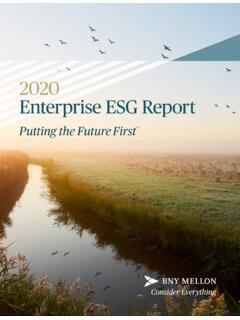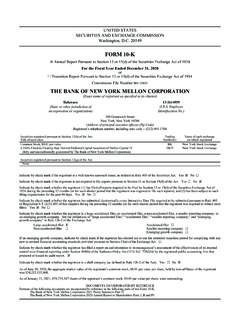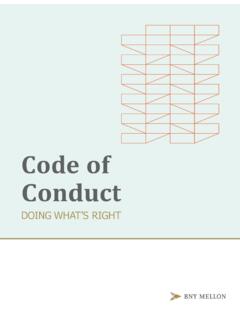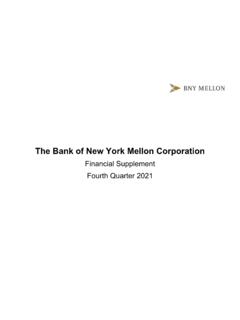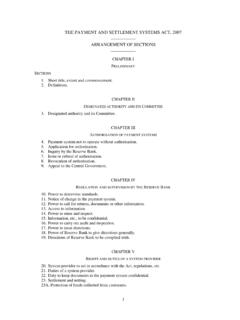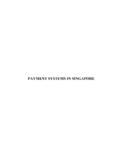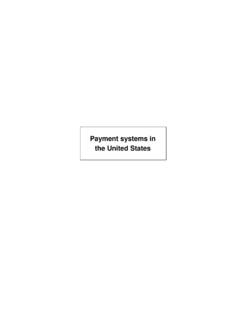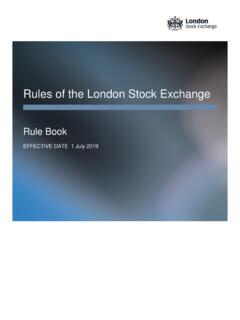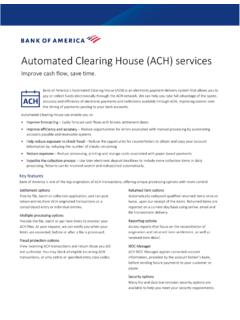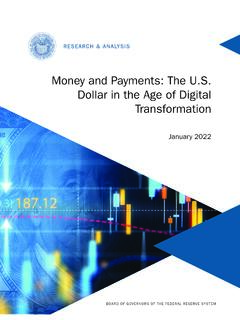Transcription of ISO 20022 A Deep Dive on Pacs
1 ISO 20022 : A Deep Dive on TREASURY SERVICES 1 FEBRUARY 2021 The ( ) message the ISO 20022 equivalent of existing MT103, MT103+, MT 103 Remit, MT102 and MT102+ messages is part of the CBPR+ portfolio and will be exchanged in the interbank cross-border leg of payments from November 2022. It is sent by the debtor agent to the creditor agent directly or through other agents and/or a payment clearing and settlement system and is used to move funds from a debtor account to a creditor. Like the messages it will replace, to use a message either the debtor, the creditor or both must be a non-financial institution. Breaking down the message The message is significantly bigger and more structured than the MT103, and breaks down into two main parts: Group Header: the set of characteristics shared by all individual transactions included in the message Credit Transf er Transaction Information: the set of elements providing information specific to the individual credit transfer The Group Header and Credit Transfer Transaction Information contain a number of different elements, as outlined below.
2 Agents To ensure f ull transparency is maintained throughout the payment chain, the message contains dedicated f ields for many more agents than its MT equivalents ( , the introduces new, dedicated fields for certain agents that would previously be contained in Field 72 an optional field in MT equivalent messages that can be used to specify additional information). The Debtor Agent (MT equivalent =Field 52a) The Creditor Agent (MT equivalent = Field 57a). The Instructing Reimbursement Agent, Instructed Reimbursement Agent and the Third Reimbursement Agent (MT equivalents = Field 53a, Field 54a and Field 55a respectively). Intermediary Agent 1 (MT equivalent = Field 56a). Unlike MT messages, the message also contains dedicated fields for Intermediary Agent 2 and 3. The Previous Agent 1, 2 and 3 will also have dedicated fields in ISO 20022 A Deep Dive on ISO 20022 : A Deep Dive on TREASURY SERVICES 2 ISO messages are also introducing a new concept surrounding the Sender and Receiver information.
3 In order to make routing easier and increase transparency regarding who is the sender and receiver, this information will be included in the payment payload as part of the payment instruction, as well as in the header of ISO messages: these are the Instructing Agent and the Instructed Agent Identifying Agents When it comes to identifying an Agent, ISO messages offer three main methods: BIC clearing System Member ID Name and postal address albeit in a f ar more granular, structured way than MT messages. Each element of a postal address in a message has a dedicated field, whether street name, building number, f loor, etc. Parties In a message there are f ive parties, three of which are completely new. The Debtor (MT equivalent = Field 50a) The Creditor (MT equivalent = Field 59a) The Ultimate Debtor new to ISO messages is the Party on whose behalf the Debtor is instructing the payment The Ultimate Creditor again, new to ISO messages is the Party on whose behalf the Creditor is receiving the payment The Initiating Party is defined as the party on the initiative of which the payment data is established.
4 Party identification uses the same structured postal address as when identifying an Agent. It is important to note that it is recommended that structured addresses are in place by November 2023 and could even be mandated as early as November 2025. Account Structure The account structure for ISO messages has been made much richer than the equivalent MT messages breaking down into five headings, four of which are new to ISO messages. The Account Identification, which is the ISO equivalent of Subfield 1, is a mandatory field for an International Bank Account Number (IBAN), Basic Bank Account Number (BBAN) or universally unique identifier (UUID). In addition the f our new f ields offer the option of including the type and currency of the account, a chosen name and a proxy. The account component is not available for the Ultimate Debtor, Ultimate Creditor and Initiating Party. settlement Information/ settlement Method The settlement Method is a new f eature containing four codes that help indicate the correct settlement method: clearing System: code Indicates that the payment has been executed using an RTGS system.
5 Cover Method: code COVE. Makes it significantly easier to determine whether the message needs to be covered. Instructed Agent: code Indicates the settlement Account is maintained by the Instructed Agent. Instructing Agent: code Indicates that the settlement Account is maintained by the Instructing Agent. ISO 20022 : A Deep Dive on TREASURY SERVICES 3 Identification Field Unlike the MT103 which has only one identification field, has six identification elements: Message Identification (provides an identification for the whole ISO 20022 message.). Instruction Identification (the ISO equivalent of Field 20). At the beginning of the migration, it will be limited to 16 characters to avoid truncation when translating between MX and MT messages. End-to-End Identification (the equivalent of Field 21 in an MT 202 COV message). Transaction Identification (a new f ield that is allocated by the Debtors Agent and must be transported to the Creditor Agent unchanged).
6 Unique End-to-end Transaction Reference (UETR) (in Field 121, Block 3 in MT messages), is a string of 36 unique characters featured in all payment instruction messages carried over SWIFT. clearing System Reference (exclusively used by RTGS systems) Payment Type Information Three of the five elements are particularly important: Service Level: provides the option to include a code from the ISO code list, but it is also where the gpi service level codes are transported ( , G001). Local instrument: used by those communities that have a certain service agreement in place. Category purpose: where a preference regarding the way the payment instruction is to be processed can be input. Amounts In FIN MT messages the currency, amount and date is contained in a single field (Field 32a). The ISO equivalent, however, contains two dedicated fields one for Interbank settlement Amount/Currency and another for Interbank settlement Date. In ISO messages there is also elements for the Instructed Amount, Charge Inf ormation Amount, Total Interbank settlement Amount and the various amounts in Structured Remittance Information.
7 Charges The Charge Bearer, the ISO equivalent of Field 71a, is split into four: CRED (MT equivalent = Field 71a BEN DEBT (MT equivalent = Field 71a OUR) SHAR (MT equivalent = Field 71a SHA) SLEV. A new code only used by schemes such as SEPA and RTGS to indicate a common service agreement, so not for use in cross-border payments . There is also another block of information, known as Charge Information, which is new for ISO 20022 messages and is designed to drive transparency regarding the amount of charges taken and the agent that took the charges. Instruction for Agents ISO introduces two fields that allow you to give instruction to agents: Instruction for Creditor Agent (equivalent to the Field 23E) contains several instruction codes, such as hold the cash f or the creditor, pay the beneficiary by cheque etc. Instruction for Next Agent. A new, dedicated point-to-point field in which every receiver in the payment chain will have its own instruction from the sender.)
8 ISO 20022 : A Deep Dive on TREASURY SERVICES 4 Remittance Information The Related Remittance Information is a brand new component that allows remittance information to be sent outside of the payment instruction. It is broken down into two elements, the Remittance Identification and the Remittance Location Details. There is also a f urther two blocks that fall under Remittance Inf ormation: Unstructured Remittance Information and Structured Remittance Inf ormation. It is to be noted that the use of the Structured Remittance Information (new compared to FIN MT) must be bilaterally agreed. Translation Principles Between November 2022 and November 2025 the message will coexist with these MT equivalents, which will then be removed from the SWIFT network at the end of the period. During this time, participants will have to translate between the MT 103 and In preparation, SWIFT has made its translation tool, which translates and truncates based on a set of message priorities, available on MyStandards.
9 BNY Mellon is the corporate brand of The Bank of New York Mellon Corporation and may also be used as a generic term to reference the Corporation as a whole or its various subsidiaries generally and may include The Bank of New York Mellon, 240 Greenwich Street, New York, New York 10286, a banking corporation organized and existing pursuant to the laws of the State of New York and operating in England through its branch at One Canada Square, London E14 5AL, England. The information contained in this brochure is for use by wholesale clients only and is not to be relied upon by retail clients. Not all products and services are offered at all locations. This brochure, which may be considered advertising, is for general information and reference purposes only and is not intended to provide legal, tax, accounting, investment, financial or other professional advice on any matter, and is not to be used as such. BNY Mellon does not warrant or guarantee the accuracy or completeness of, nor undertake to update or amend the information or data contained herein.
10 We expressly disclaim any liability whatsoever for any loss howsoever arising from or in reliance upon any of this information or data. We wish to inform you that whilst The Bank of New York Mellon ( BNY Mellon ) is authorised to provide financial services in Australia, it is exempt from the requirement to hold, and does not hold, an Australian financial services licence as issued by the Australian Securities and Investments Commission under the Corporations Act 2001 (Cth) in respect of the financial services provided by it to persons in Australia. BNY Mellon is regulated by the New York State Department of Financial Services and the US Federal Reserve under Chapter 2 of the Consolidated Laws, The Banking Law enacted April 16, 1914 in the State of New York, which differs from Australian laws. If this material is distributed in, or from, the Dubai International Financial Centre ( DIFC ), it is communicated by The Bank of New York Mellon, DIFC Branch, regulated by the DFSA and located at DIFC, The Exchange Building 5 North, Level 6, Room 601, Box 506723, Dubai, UAE, on behalf of The Bank of New York Mellon, which is a wholly-owned subsidiary of The Bank of New York Mellon Corporation.



